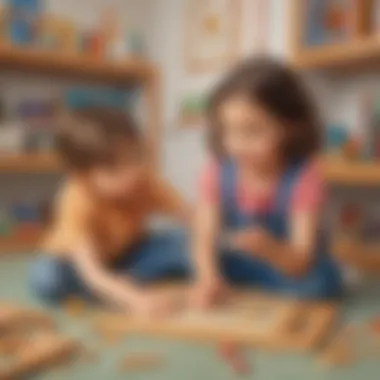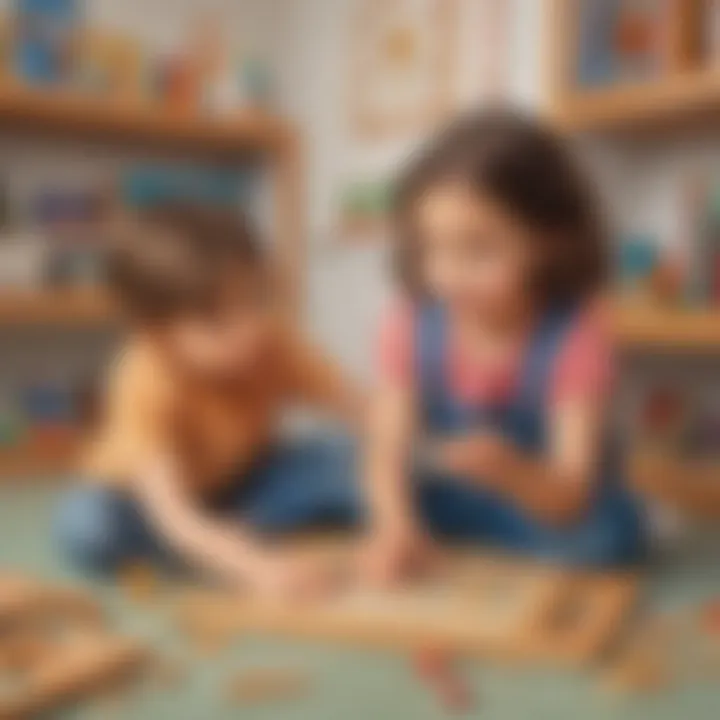Mathematics for Five-Year-Olds: Building Future Minds


Intro
Mathematics plays a crucial role in cognitive development, especially at an early age. For five-year-olds, this age can be a pivotal moment to introduce essential concepts. This foundation builds not only mathematical understanding but also problem-solving skills and logical thinking. The approach is about fostering curiosity and making learning a natural part of daily play. This section will explore creative activities, engaging quizzes, and informative articles tailored for both children and their caregivers. Each aspect contributes to a comprehensive understanding of mathematics that can last a lifetime.
Creative Activities
Engaging young learners in creative activities is a powerful way to introduce mathematical concepts. These activities do not merely serve the purpose of entertainment but also significantly enhance learning outcomes.
Craft Ideas
Children love to create, and incorporating mathematics into craft projects is an effective way to teach. Here are some thematic craft ideas:
- Shape Cutouts: Use colored paper to cut out various shapes. Let children create pictures using triangles, squares, and circles.
- Counting Crafts: Provide simple objects, such as buttons or stickers, and encourage children to group them in various ways or graph them.
Step-by-Step Guides
Clear instructions make activities accessible. Each craft can have simple steps like:
- Gather all required materials.
- Explain each step verbally while demonstrating.
- Allow children to explore their creativity with minimal guidance afterward.
Educational Value
These creative activities foster fine motor skills as children cut, paste, and color. Moreover, they help children understand essential mathematical principles, like shape identification and counting skills – forming the building blocks of further learning.
Fun Quizzes
Quizzes present another intriguing way to engage five-year-olds in mathematics. They can be assessed without the pressure of traditional testing.
Quiz Topics
Numerous topics can be covered, encompassing:
- Number recognition
- Basic addition and subtraction
- Patterns and sequences
Question Types
Fun and variety can keep children engaged. Various question types include:
- Multiple choice
- True or false
- Visual prompts, where children select correct answers from images
Knowledge Reinforcement
Quizzes help solidify knowledge by encouraging recall. By participating in quizez after lessons, children are more likely to retain what they learn. The informal setting reduces stress, allowing for better engagement.
Fact-Based Articles
Reading age-appropriate articles is beneficial as well. Informative content bridges the gap between play and learning.
Topics
These articles can cover several important math topics ideally suited for five-year-olds:
- The number line introduced simply
- How recipes can introduce measurements
- Games involving chance, like dice and card games
Engaging Content
It helps when the content is engaging and relatable. Using simple language, articles can discuss subjects like shapes encountered in everyday life – furniture, toys, etc.
Importance of Early Mathematics Education
Mathematics education in early years serves as a cornerstone for various cognitive abilities. It is more than just counting or recognizing numbers. Educators and parents are starting to acknowledge that a strong mathematical foundation leads to enhanced problem-solving and critical thinking. The importance of early mathematics education lies in its profound impact on future learning trajectories.
Cognitive Development in Young Learners
At the age of five, children's brains are extremely receptive to new information. Cognition evolves rapidly, making this period critical. Engaging in math helps develop neural pathways associated with logical thinking and reasoning. Young learners start to understand abstract concepts through fun activities such as games and visual aids. For instance, counting objects in a playful setting not only introduces numerical values but also improves attention spans and memory skills.
"Understanding mathematics at a young age enhances cognitive pathways better than most other skills."


Research indicates that forms of play integrated with math enhance brain development much more significantly than rote memorization.
Key Benefits of Cognitive Development through Mathematics:
- Logical Reasoning: It cultivates analytical thinking by allowing children to learn through problems they can solve.
- Language Development: Children acquire mathematical vocabulary, which is important for expressing ideas clearly.
- Social Skills: Working with peers on math tasks enhances cooperation and social interaction.
In summary, early exposure to mathematical concepts sharpens young minds and prepares them for future academic challenges. Montessori-inspired activities or structured games can foster this growth effectively.
Building a Foundation for Future Learning
Foundational knowledge in mathematics shapes a child's learning experiences later. Children who grasp basic math concepts more readily adapt to challenges found in science and higher mathematics. This enables smoother access to a broad array of subjects within the sciences.
Moreover, introducing mathematical concepts early serves to boost confidence. A boost in self-assurance is vital; children who excel in basic math components often embrace more complex topics without fear of failure.
Components of a Strong Mathematical Foundation:
- Number Sense: Understanding numbers' meanings allows students to transpose everyday counting into comprehensible data.
- Problem Solving Skills: Strategies learned early motivate children to find multiple solutions to a given problem, promoting creativity.
- Resilience: Exposure to challenging concepts prepares children to tackle difficulties ahead. Math isn't just about being correct; failure also plays a role in learning.
Efforts should be made by both educators and parents to recognize and nurture these foundations. Consistent practice and engagement can yield significant results, ensuring that children view math not merely as a subject but as a language of logic and order applicable in daily life.
Key Concepts in Mathematics for Five-Year-Olds
Understanding key concepts in mathematics is essential for five-year-olds. These concepts form the building blocks of more complex mathematical ideas that children will encounter in their academic future. At this tender age where cognitive flexibility is high, introducing young learners to mathematical principles paves the way for future academic success and instills a love for learning.
Children at this stage are not only preparing for more advanced studies in math but also expanding their problem-solving abilities and logical reasoning. Thus, exposing them to foundational concepts of mathematics can encourage curiosity and analytical skills well into their later years.
Number Recognition
Number recognition lays the groundwork for further numerical understanding. It involves teaching children to identify and name numbers, which is their first encounter with quantitative concepts. This stage significantly impacts a child’s confidence and ability in more complex areas like addition and subtraction.
When children recognize numbers, they start to understand their meanings. This knowledge can be strengthened through engaging activities like counting chains using blocks or number games. Activities which include daily interactions with numbers often make this learning persistent and useful beyond the classroom.
Basic Operations: Addition and Subtraction
Introducing basic operations, specifically addition and subtraction, are key mathematical skills that begin to develop young learners’ number sense. It is crucial for children to grasp the idea of combining (addition) and separating (subtraction) quantities as it appears throughout life and not only in math.
Educational games can support this learning through fun scenarios where kids visualize adding and removing objects. For instance, they might start with a certain number of apples and then choose some to “share” with a friend. Understanding these operations can lead to more advanced concepts in mathematics.
Shapes and Spatial Awareness
Learning about shapes and developing spatial awareness is equally significant at this age. Being familiar with different shapes fosters categorization skills in children. They start recognizing geometric shapes in everyday objects around them, which helps give them a sense of the world they inhabit.
Spatial awareness extends beyond mere recognition; it includes understanding how objects relate to one another in space. Simple activities, such as building with blocks, can enhance spatial skills. Through hands-on exploration, five-year-olds can visualize changes as they manipulate shapes, which nurtures analytical thinking.
Measurement and Comparison
Measurement and comparison introduce children to concepts of size, length, and mass. This foundation is important for understanding the physical properties of objects and establishing reasoning skills. Different tools, such as rulers or balance scales, can give children direct experience in measuring quantities.
Children often engage in everyday comparisons, like deciding which toy is bigger or assessing whose height is taller. This information prompts discussions about difference and similarity, making such concepts relatable and easier to grasp.
Patterns and Relationships
Recognizing patterns and understanding relationships among quantities are foundational for mathematical reasoning. Patterns can involve both visual elements—like color sequences—or numbers, and they are crucial for developing predictive skills. Children trained in this practice can enhance their cognitive skills in recognizing repeating sequences.
Activities can include sorting objects by color or arranging toys in a specific order. As they learn to identify patterns, they begin to predict what might come next, which is a valuable cognitive leap and a stepping stone to algebra in the future.
Teaching five-year-olds these key concepts in mathematics builds a solid platform for future learning while enriching their intellectual and social skills. The more these principles are integrated into play and daily communication, the stronger the apliction for developing mathematical understanding becomes.
Effective Teaching Strategies for Mathematics
When introducing mathematics to five-year-olds, the strategies employed by educators and caregivers are critical. Effective teaching methods determine how well children grasp fundamental concepts in math and set the groundwork for their future learning experiences. The right approaches can ignite an interest in mathematics and foster a positive attitude towards the subject.
Features like interactive learning, visual aids, and real-life applications enhance understanding while keeping young minds engaged. These strategies tailor learning experiences to individual needs and make mathematically concepts easier to grasp.
Interactive Learning through Play
Play is a natural inclination for five-year-olds. Using playful interactions to teach math not only makes learning enjoyable, it also reinforces concepts. For example, incorporating games that use counting or measuring enhances numerical understanding. Activities like clay modeling can aid in grasping shapes and space. Games such as “Number Match” encourage recognition of numbers in a fun, pressure-free environment.
These methods help clear the barriers children might feel toward math. When kids play math-based games, it fosters not just an understanding of math, but a love for it. This is how early engagement turns into long-term mathematical efficacy.


Use of Visual Aids and Manipulatives
Visual aids, such as charts or graphs, can illuminate complex concepts. When children see tangible objects related to mathematical ideas, they can better internalize information. Using familiar items like blocks or toys for counting helps link mathematical concepts to reality. Young learners can touch, move, and understand math instead of just viewing numbers on screen.
Manipulatives are essential in making abstract concepts concrete. For instance, showing ten apples in a basket visually demonstrates the number ten. Making learning concrete helps in the gradual transition from hands-on experience to abstract thinking. The combination of seeing and doing establishes a strong pathway to understanding.
Incorporating Real-Life Examples
Real-world applications of mathematics aid comprehension. Children easily relate to examples they observe in their daily life. Verbalize math concepts through simple activities like cooking or grocery shopping. Ask questions like, “If we have three apples and I give you two, how many do you have?” This teaches addition and subtraction in an engaging way.
Recognizing patterns in nature or conducting small experiments can also solidify mathematical ideas. Real-life connections help create a relevance that elevates subjects from mere theories to practical skills. Constant reinforcement solidifies relate the math to life, enhancing its significance in a child's growing framework for either fundamental or complex ideas
Encouraging Collaborative Learning
Collaboration among children fosters communication and interaction during learning. Working on group activities encourages peer learning. Activities such as solving math puzzles in pairs promote discourse. Children become problem solvers as they explain their reasoning to each other. This positive social interaction encourages confidence while enhancing mathematical skills.
Group settings mimic real-world scenarios, reinforcing the value of teamwork. Such environments help children learn that math is not just an isolated skill but is integrated within various contexts. This fusion of skill and social interaction aids retention and enthusiasm for mathematics.
Engaging children through interactive strategies in an enjoyable way fosters a long-lasting appreciation for mathematics that extends beyond the classroom.
By implementing these effective teaching strategies in mathematics, teenagers and mentors can contribute actively to learner identity-development, ensuring foundational skills for the future.
Resources for Learning Mathematics
Accessing various resources is vital in enriching the mathematical journey of five-year-olds. These resources not only enhance understanding but also create engaging experiences that make learning enjoyable. They help imbue young learners with the foundational skills needed to excel in mathematics as they develop.
It's important to consider the type of resources that best serve different needs of children. Each tool can cater to diverse learning paces and styles, ensuring no child is left behind. This includes books, apps, games, and activity guides that are specifically tailored to this age group. All of these elements contribute to a lifelong love for mathematics and learning as a whole.
Books and Activity Guides
Books remain one of the foundational resources in a young learner’s education. Interactive books, in particular, grab the attention of children. While some books focus on number recognition, others might weave mathematical concepts into stories making it relatable. Recommendations include popular titles like "Push, Pull, Empty, Full" by Clara Vulliamy and "How Many?" by Chris Butterworth. Each book can serve to not only teach mathematical ideas but also promote comprehension skills.
Activity guides complement these books by providing structured exercises. These guides might involve activities like counting objects or creating simple patterns with household items. The aim should be simplicity, encouraging children to apply their mathematical knowledge confidently.
Educational Apps and Online Tools
In today’s digital world, educational apps and online tools have become significant resources. They offer flexible learning options and allow for self-paced exploration. Popular applications such as "Endless Numbers" and "Todo Math" provide interactive ways for children to practice their skills. An interactive element fosters engagement in a way that television or traditional classroom methods may lack.
Using tablets or phones as learning tools makes mathematics readily accessible. Notably, many apps also track progress, allowing parents to gauge their children's understanding. Make sure to read reviews and choose age-appropriate apps so your child benefits from a well-designed learning experience.
Games and Puzzles
Games and puzzles play a crucial role in developing mathematics skills in young learners. They provide a fun, hands-on approach to understanding concepts. Board games like "Chutes and Ladders" or even card games can enhance not only counting skills but also strategic thinking.
Puzzles, such as shape sorting toys or simplified math puzzles, offer practical learning experiences. They can sharpen problem-solving skills while engaging young children.
Offering a balanced variety of resources—books, apps, and games—helps in nurturing a more comprehensive mathematical competence.
Children learn best when they are motivated and having fun.
By choosing effective mathematics resources for five-year-olds, parents, educators, and caregivers can help lay an essential groundwork for their future learning. Each resource can have a lasting impact, influencing the child's perception of mathematics as a subject not just of numbers, but as a critical way to understand the world.
Parental Involvement in Mathematics Education
Parental involvement in mathematics education is critical in shaping a child’s understanding and appreciation for math at a young age. When parents take an active role, they not only foster their child's skills but also contribute to a more positive attitude towards learning. Engaging with mathematics does not always have to be structured; instead, informal learning opportunities are just as crucial. Through daily interactions, parents can facilitate a child's curiosity about numbers and patterns.
The benefits of fostering such involvement are extensive. Firstly, children with engaged parents often show improved performance in math. Learning becomes a shared experience that connects the home and school, creating consistency and reinforcing skills. Moreover, parents help demystify mathematics by adding context, which solidifies concepts in a practical and relatable manner. Ultimately, this environment encourages children to embrace technical challenges rather than viewing math as a daunting obstacle.
Creating a Supportive Learning Environment
Creating a supportive learning environment requires an active approach. Parents should arrange a designated space in the home that is conducive to learning. This can include a quiet spot for activities involving numbers, artwork linked to shapes, or even simple organization of math tools like toys used for counting.
Besides physical space, it is also essential for parents to cultivate a positive mindset towards math. For instance, showing excitement when discussing numbers or solving puzzles can make a significant difference. Children are impressionable, and a parent's enthusiasm (or lack thereof) for mathematics tends to shape the child’s own feelings about the subject. Building an environment that celebrates small achievements helps. Applications of simple math concepts around the home—whether measuring ingredients while cooking or sorting objects by size—support everyday learning and growth.
Engaging in Mathematical Conversations
Engaging in mathematical conversations further deepens a child's understanding of math. Simple dialogues about quantities during playtime or comparing prices while shopping can introduce mathematical language naturally. Asking open-ended questions is an effective strategy here. Questions such as “How many do you think are in that box?” encourage critical thinking and estimation.
Moreover, parents can integrate math vocabulary into conversations. Using terms like


Assessing Young Learners' Mathematical Understanding
Assessing young learners' mathematical understanding is an essential aspect of early education. This process is not merely about assigning grades or scores; it is about unlocking the cognitive abilities that lie within five-year-olds. Assessment in early mathematics is vital as it provides insights into a child's learning progress, enabling teachers and parents to adapt methods that suit individual learning styles.
Assessment plays a crucial role in identifying gaps in knowledge. It allows educators to recognize where a child struggles and where they excel. This informed approach is beneficial for developing customized learning paths that ensure children don’t merely adopt a surface-level understanding.
Furthermore, assessing young learners fosters confidence and curiosity. When children see progress through assessments, they feel accomplished, which boosts their willingness to tackle more complex problems. Educators can monitor changes and advancements, therefore enhancing engagement and building an interest in mathematics.
As important as assessments are, it is essential to consider factors that may influence their outcomes. Stressful assessment experiences can hinder a child from demonstrating true understanding, turning the evaluation into a barrier rather than a facilitator.
Observational Methods
One critical approach to assessment is through observational methods. These methods involve watching children as they interact with mathematical concepts. When a child engages in problem-solving during play or group activities, ample learning opportunities surface.
Observations allow educators to gather qualitative data that numbers alone cannot provide. By witnessing how children tackle tasks and share their thoughts aloud, teachers gain insight into their reasoning processes.
Observation not only gauges skills but also recognizes enthusiasm and interest levels in different areas.
Essential elements of effective observational assessment include:
- Structured Plans: Adopting specific goals for each observation ensures that crucial aspects are not overlooked.
- Frequent Monitoring: Regular checks allow for a more discerning assessment of progress over time.
- Variety of Settings: Observing in diverse contexts reveals behavior changes in different learning environments, thus offering richer data.
Informal Assessment Techniques
Informal assessment techniques come into play as another means of gauging young learners' understanding of mathematics. These methods often include games, discussions, and hands-on activities, which can yield significant insights without the rigidity of formal assessments.
Engaging children in math-related discussions during everyday routines can uncover essential understanding. Whether it's talking about numbers while shopping or discussing shapes found in nature, contextual learning solidifies mathematical concepts.
Some informal assessment techniques may include:
- Games: Interactive games stimulate children’s interest in math while allowing teachers to assess skills in a relaxed environment.
- Peer Interaction: Group activities show how children collaborate and communicate mathematically, indicating their level of understanding.
- Real-Life Applications: Making connections to real-life scenarios help assess a child’s grasp of concepts in a meaningful context.
When applied wisely, observational methods and informal assessments facilitate a deeper understanding of mathematical skills in young learners. By utilizing these strategies effectively, educators reinforce not just knowledge but also enthusiasm for mathematics.
Challenges in Teaching Mathematics to Five-Year-Olds
Teaching mathematics to five-year-olds involves several notable challenges that educators and parents need to understand for effective learning. The age of five is often characterized by rapid development but also by significant variability in learning styles and rates. Acknowledging these challenges is essential, not only for the success of early mathematical engagement but also for fostering a lifelong appreciation of numbers and problem-solving.
Addressing Misconceptions
Children are often filled with intuitive but incorrect notions about numbers and operations. Early misconceptions might include beliefs such as "adding makes everything bigger," which can lead to confusion when introduced to more complex concepts like negative numbers or subtraction. It is crucial for adults who teach these early mathematical concepts to identify and address these misconceptions immediately.
Two effective strategies for this include:
- Using concrete examples: Instead of abstract representations, utilize objects that children can see and touch. If they understand what it looks like to physically combine 2 apples and 3 apples, learning addition becomes more tangible and intuitive.
- Encouraging questions: Create an atmosphere where children feel safe to express their thoughts and doubts. Engage them in dialogues about their reasoning. When trained to articulate their misunderstandings, children might find the clarity they need to move forward.
Overall, addressing misconceptions is a step that cultivates a constructive learning environment. It prevents the perpetuation of errors that can harm later discussions about math.
Managing Varied Learning Paces
Every child has a distinct learning pace influenced by multiple factors. These include cognitive development, prior experiences, and individual interests. Differentiating instruction becomes crucial in such a setting. Educators must be flexible when engaging children in mathematical activities.
A few supportive measures can be employed:
- Group activities: Use small group learning, allowing children at varying levels to work together on the same problem. For instance, involve stronger students in explaining solutions to their peers; this approach reinforces understanding for both groups.
- Personalized tasks: Assess individual competency regularly. Some children may get more challenging tasks involving simple addition while others may need to revisit basic concepts such as number recognition before moving forward.
In all, managing varied learning paces emphasizes respect for each child's journey. Successful mathematics education should accommodate different timelines and eliminate the pressure to conform to a standardized benchmark.
Recognizing and addressing challenges early lays the groundwork for confidence and competence in mathematics throughout schooling.
Encouraging a Positive Attitude Towards Mathematics
Encouraging a positive attitude towards mathematics is crucial for young learners. When children feel good about math, they are more likely to engage with it. This can lead to a better understanding of mathematical concepts. A positive mindset helps reduce anxiety associated with the subject. Children can develop confidence as they learn rather than fear failure. This foundation fosters long-term educational benefits.
Fostering Curiosity and Exploration
Curiosity is a significant driver of learning. For five-year-olds, fostering curiosity in mathematics means encouraging exploration. Parents and educators can stimulate this curiosity through hands-on activities. Something as simple as counting toys or measuring ingredients for a recipe can excite learning. Asking open-ended questions can lead to deeper engagement. Instead of providing direct answers, encouraging children to think provides valuable skills for their future. When curiosity is nurtured, children feel empowered to explore math concepts on their own.
Promoting Resilience and Problem-Solving Skills
Promoting resilience helps children face challenges comfortably. Mathematics is about problem-solving. When young learners encounter difficulties, supporting them to persevere is key. This can involve guiding them through reasoning processes or letting them make mistakes. For young learners, mistakes are excellent opportunities for learning. Simple strategies, like breaking down problems into smaller steps, can reinforce this behavior. Engaging in collaborative activities helps children learn to communicate their thinking and share different strategies. It builds resilience by understanding that math is often a series of attempts and adjustments.
An encouraging environment not only nurtures mathematical skills but also prepares young minds for complex problem-solving situations in the future.
Overall, a supportive attitude towards math lays a solid groundwork for lifelong learning. It empowers children, helping them view math as a tool for exploration rather than a barrier to overcome. Encouraging young minds in this way is essential for their growth.







